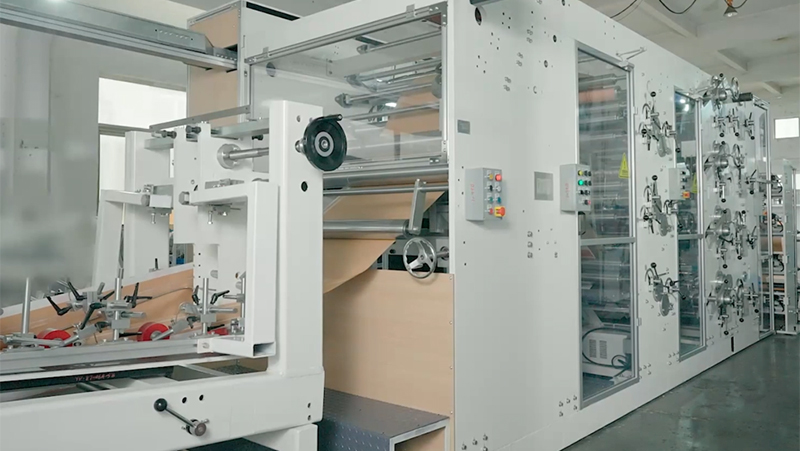Key Components and Functions of Paper Bag Manufacturing Equipment
Release time:2025-05-23 Classification:Knowledge
The production of paper bags relies on specialized machinery designed to transform raw materials into durable, functional packaging. Understanding the core parts of a paper bag machine is essential for optimizing efficiency, ensuring product quality, and minimizing downtime. This article explores the critical components that enable these machines to perform tasks such as cutting, folding, gluing, and finishing with precision.

1. Feeder Unit
The feeder unit is the starting point of the paper bag manufacturing process. It systematically delivers rolls of paper or pre-printed sheets into the machine. This component ensures consistent material alignment and tension control, which are vital for maintaining uniform bag dimensions. Advanced feeder systems incorporate sensors to detect irregularities, such as paper jams or misalignment, triggering automatic adjustments to prevent waste.
2. Printing System (Optional)
For machines equipped with integrated printing capabilities, this subsystem applies designs, logos, or text to the paper substrate. It typically includes ink reservoirs, rollers, and drying mechanisms. High-precision registration systems ensure that prints align perfectly with subsequent cutting and folding steps. Depending on the machine type, flexographic or offset printing technologies may be employed.
3. Cutting and Creasing Assembly
This assembly consists of rotary blades and creasing tools that cut the paper into specific shapes while creating fold lines for later steps. The cutting mechanism must maintain razor-sharp edges to avoid fraying, while creasing wheels apply controlled pressure to form crisp, easy-to-fold edges. Adjustable settings allow operators to accommodate different bag sizes and styles.
4. Folding and Gluing Mechanism
Once cut, the paper moves to folding stations where mechanical arms or vacuum-assisted guides shape it into a bag structure. The gluing unit then applies adhesive to designated areas—typically the side seams and bottom folds. Hot-melt adhesives are commonly used for their fast curing time and strong bond. Precision nozzles ensure glue is distributed evenly without overspill, which could compromise bag integrity.
5. Bottom Pasting and Reinforcement
For flat-bottom or satchel-style bags, a dedicated station reinforces the base. This involves layering additional paper strips or applying adhesive in a cross-pattern to enhance load-bearing capacity. Some machines include ultrasonic sealing technology for eco-friendly, glue-free bonding.
6. Handles Attachment Unit (If Applicable)
Machines producing handled bags integrate a subsystem to attach twisted paper handles, die-cut loops, or ribbon ties. This component synchronizes with the main conveyor to position handles accurately before securing them with adhesive or heat-sealing. Tension control is critical to prevent handles from detaching during use.
7. Drying and Curing Section
After gluing, bags pass through a drying tunnel where heated air or infrared systems accelerate adhesive curing. Temperature and airflow are carefully calibrated to avoid warping the paper or causing premature drying, which could lead to weak seams.
8. Stacking and Ejection System
Finished bags are counted and stacked into batches for packaging. Automated suction cups or robotic arms transfer products to conveyors or collection bins. Sensors monitor stack height and weight to ensure consistency, while anti-static devices prevent paper sheets from clinging together.
9. Control Panel and Automation Software
Modern paper bag machines rely on programmable logic controllers (PLCs) and touchscreen interfaces to manage operations. Operators input parameters like bag dimensions, production speed, and glue quantity. Real-time diagnostics alert users to mechanical issues, and some systems feature predictive maintenance algorithms to reduce unplanned stoppages.
Maintenance Considerations for Longevity
Regular upkeep of paper bag machine parts is crucial for sustained performance:
- Blades and Cutting Tools: Sharpen or replace worn blades to maintain clean cuts.
- Gluing Nozzles: Clean adhesive residues daily to prevent clogging.
- Conveyor Belts: Inspect for wear and adjust tension to prevent slippage.
- Sensors and Actuators: Calibrate optical sensors and lubricate moving parts periodically.
Innovations in Paper Bag Machinery
Recent advancements focus on sustainability and speed. Energy-efficient motors, biodegradable adhesive options, and AI-driven quality control systems are becoming industry standards. Modular designs also allow manufacturers to retrofit older machines with upgraded components, extending equipment lifespan.
By understanding the roles and maintenance requirements of these components, operators can maximize productivity while producing high-quality paper bags tailored to diverse commercial needs. Whether crafting simple grocery bags or premium retail packaging, each part of the machine plays a pivotal role in transforming raw paper into a functional, eco-conscious product.






